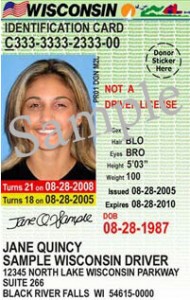 You must have heard about the now 10 days of protests by union workers in Wisconsin, aka “Crisis in Dairyland: Revenge of the Curds” (via The Daily Show). But did you hear about Thursday’s ploy to lure the Democratic Senators back to the capitol by debating a bill that would require voters to show photo-ID before casting a vote? No?
You must have heard about the now 10 days of protests by union workers in Wisconsin, aka “Crisis in Dairyland: Revenge of the Curds” (via The Daily Show). But did you hear about Thursday’s ploy to lure the Democratic Senators back to the capitol by debating a bill that would require voters to show photo-ID before casting a vote? No?
The Wisconsin photo ID bill was the most stringent of the more than 20 states that have introduced or indicated they will introduce such legislation. The original bill called for voters to show an ID which had been issued to them by the Wisconsin Department of Transportation (DOT) in order to vote. That would mean that anyone with an out-of-state driver’s license, a military ID, a student ID, a Tribal ID, even a U.S. passport, would have to go to the Wisconsin DOT and get another ID just to be able to vote. Not to mention all those people without photo-ID who would have to obtain one.
Proponents of photo-ID bills claim that the new law will stop in-person voting fraud, but there are no examples of such fraud occurring on a remotely widespread basis. The primary outcome of the bill is that it would undoubtedly lower the number of students and economically disadvantaged people who vote in Wisconsin. Because these populations traditionally vote for Democrats in larger numbers, it’s no surprise (almost clever) that Republicans would use this threat as a ploy to get Democrats back to the State House.
Some amendments adopted by the Wisconsin Senate on Thursday expand the types of photo-ID that a voter can show before voting, which is definitely an improvement, but if the bill passes there will still be hundreds of thousands of Wisconsin residents that don’t have a driver’s license or state ID card (disproportionately those who are elderly, women, minorities, students, or disabled voters) and will have to get one in order to vote.
Getting a DOT ID might not sound hard, but there are two huge obstacles: first, many people don’t have the documents they need to prove who they are (e.g. they might not have a birth certificate or copy of their naturalization papers); and second, many more can’t get to a DOT during the few hours of the week that they are open due to busy work, and school schedules.
Meanwhile, there are many ways that proof of identity can be required without it being a barrier to voting for many people. For example in Nevada they simply require voters to sign the roll and compare that signature to the signature on file for the voter. In Virginia they ask for photo or non-photo-ID (such as a utility bill or bank statement), but also give you the option of executing an affidavit of identity.
Unfortunately, it’s not only Wisconsin that wants to introduce a photo ID law for voting. Bills have been filed in over 20 states, and it’s being given serious consideration in Iowa, Kansas, Maine, Maryland, Minnesota, Missouri, Montana, Nebraska, New Hampshire, South Carolina, Tennessee, and Texas and there have been discussions in North Carolina though no bill has yet been filed. There are currently 7 states which require photo-ID to vote.
For the time being, the Wisconsin bill is on hold. It includes a fiscal note (it costs a lot of money to introduce a photo ID law) and that can’t be voted on without the magic quorum number of 20 senators present. But it’s clear this fight is far from over.
Ruth Greenwood is a staff attorney with the Fair Elections Legal Network.